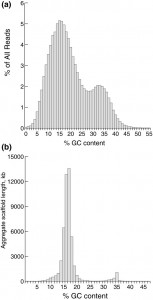
Top Ten Genomes - (v) Ich
The macronuclear genome of parasite Ichthyophthirius multifiliis was published in 2011.
Background
Ichthyophthirius multifiliis, commonly known as Ich, is a highly pathogenic ciliate responsible for ‘white spot’, a disease causing significant economic losses to the global aquaculture industry. Options for disease control are extremely limited, and Ich’s obligate parasitic lifestyle makes experimental studies challenging. Unlike most well-studied protozoan parasites, Ich belongs to a phylum composed primarily of free-living members. Indeed, it is closely related to the model organism Tetrahymena thermophila. Genomic studies represent a promising strategy to reduce the impact of this disease and to understand the evolutionary transition to parasitism.
Results
We report the sequencing, assembly and annotation of the Ich macronuclear genome. Compared with its free-living relative T. thermophila, the Ich genome is reduced approximately two-fold in length and gene density and three-fold in gene content. We analyzed in detail several gene classes with diverse functions in behavior, cellular function and host immunogenicity, including protein kinases, membrane transporters, proteases, surface antigens and cytoskeletal components and regulators. We also mapped by orthology Ich’s metabolic pathways in comparison with other ciliates and a potential host organism, the zebrafish Danio rerio.
Conclusions
Knowledge of the complete protein-coding and metabolic potential of Ich opens avenues for rational testing of therapeutic drugs that target functions essential to this parasite but not to its fish hosts. Also, a catalog of surface protein-encoding genes will facilitate development of more effective vaccines. The potential to use T. thermophila as a surrogate model offers promise toward controlling ‘white spot’ disease and understanding the adaptation to a parasitic lifestyle.
It deserves a place among unusual genomes for being extremely AT-rich (15%). In fact, it holds the record for being the most AT-rich genome sequenced so far. Previously this record was held by malaria parasite Plasmodium.

What do the extremely AT-rich and GC-rich genomes tell us about the functional properties of the organism? Very little as it turns out. There are no consistent patterns of the GC-content of genomes of eukaryotic species, and at times closely related species have wide divergence in genomic GC-content. Check various types of mosquitoes for example. Among the patterns we have seen, several ciliates seem to have AT-rich genomes. Ciliate genomes are also weird in another way, and that topic (MIC and MAC) will be covered separately as a different top ten category.